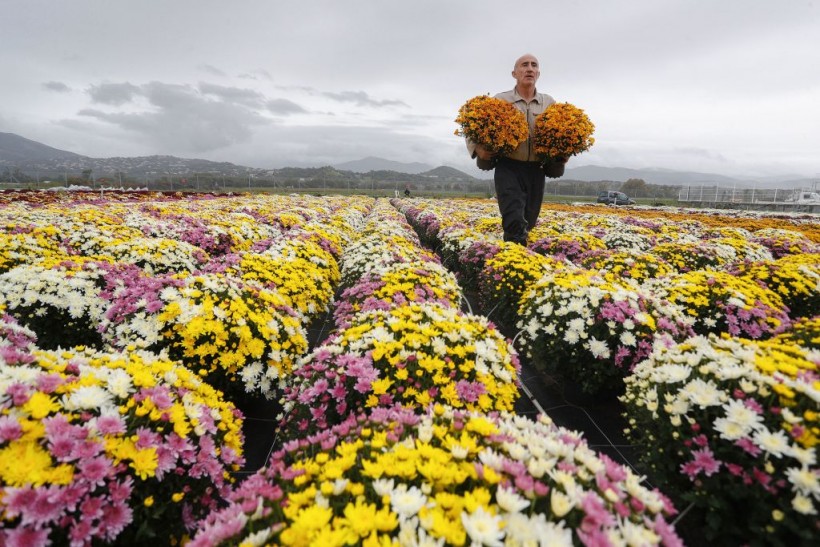Climate change is a global challenge that affects everyone, but especially those who depend on the land for their livelihood.
Farmers are among the most vulnerable groups to the impacts of climate change, such as droughts, floods, pests, and diseases. How can they cope with these changes and continue to produce food for the world?
A team of researchers from the University of Maine and the University of Vermont (UVM) have conducted the first-ever study of cultural adaptation to climate change .
They used the science of cultural evolution to examine data on which crops farmers plant across the U.S., and how they have changed over the last 14 years.
Their findings can help inspire more effective policy solutions to survive in the face of the harmful effects of global warming.
What is cultural adaptation and why does it matter?
 (Photo : PASCAL POCHARD-CASABIANCA/AFP via Getty Images)
(Photo : PASCAL POCHARD-CASABIANCA/AFP via Getty Images)

The researchers defined cultural adaptation as a population-level change, or the spread of a behavior that provides a benefit in a changed environment.
In other words, it is how people learn from each other and adopt new practices that suit their new conditions.
The lead researcher, Tim Waring, explained that humans evolve and adapt by changing their culture. He said that adaptation is about finding a better match to the environment.
Cultural adaptation is important because it can help people cope with the challenges of climate change without relying on external interventions or resources.
It can also foster innovation and creativity, as people experiment with new ideas and share them with others.
Also Read: Adapting to Climate Change Could Still Mean Environmental Troubles
How are farmers adapting to climate change in the U.S.?
The researchers analyzed data on crops planted in each county across the U.S. for the last 14 years, and compared them to the climate in which different crops grow best.
They found that for much of the U.S., farmers have changed which crops they plant in a way that better matches crops to recent changes in climate.
For example, in Maine, northern and western counties have changed crops in a way that follows recent climate change.
Some farmers have switched from potatoes to corn, soybeans, or wheat, which are more suited to warmer and wetter conditions.
However, the researchers also found that crop adaptation to climate change is not happening everywhere. In some regions, planted crops have become even less suited to climate change.
This could be due to various factors, such as market forces, infrastructure, policies, or social norms.
Waring commented that many Maine farmers are already adapting to climate change.
The researchers also explored whether climate change influenced the use of cover crops in the U.S., which are plants that protect and enrich the soil between crop cycles.
They concluded that the recent surge in cover cropping may be due to cultural adaptation, but not to climate change. Instead, it may be driven by other factors, such as peer influence, education, or subsidies.
What are the implications and recommendations for policy and practice?
The study of cultural adaptation to climate change can provide valuable insights for policymakers and practitioners who want to support farmers and other communities in coping with climate change.
By distinguishing the process of adaptation from policy goals and beneficial outcomes for society, they can design more effective and tailored interventions that address the specific needs and challenges of different groups.
The researchers suggested that policymakers and practitioners should consider the following questions when designing and implementing adaptation policies and programs:
- What are the existing cultural practices and norms that influence adaptation behavior?
- What are the potential benefits and costs of different adaptation options for different groups?
- How can information and incentives be provided to encourage learning and adoption of beneficial practices?
- How can social networks and institutions be leveraged to facilitate diffusion and coordination of adaptation behavior?
- How can feedback mechanisms be established to monitor and evaluate the outcomes and impacts of adaptation behavior?
By applying a cultural evolution perspective to climate change adaptation, policymakers and practitioners can better understand how people adapt to their changing environment, and how they can help them do so more effectively and sustainably.
Related article: Viral Dark Matter: A Potential Weapon Against Climate Change
© 2024 NatureWorldNews.com All rights reserved. Do not reproduce without permission.


![Plastic Pollution: Scientists Include Spores of Plastic-Eating Bacteria ‘Bacillus Subtilis’ to Develop 'Self-Digesting Plastic' [Study]](https://1471793142.rsc.cdn77.org/data/thumbs/full/70396/280/157/50/40/plastic-pollution-scientists-include-spores-of-plastic-eating-bacteria-bacillus-subtilis-to-develop-self-digesting-plastic-study.jpg)


